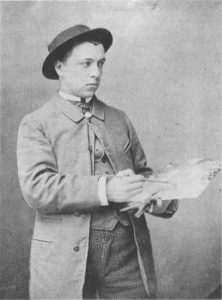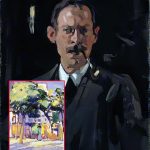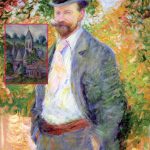This page forms part of a series of pages dedicated to the many artists who worked in Veules-les-Roses. A full list of all the artists with a link to their works can be found at the bottom of this page.

Movements: Post Impressionism, Pointillism
Paul Signac (1863 – 1935) was a French Post-Impressionist painter. He followed a course of training in architecture before, at the age of 18, deciding to pursue a career as a painter, after attending an exhibit of Monet’s work. He sailed on the Mediterranean Sea, visiting the coasts of Europe and painting the landscapes he encountered. In later years, he also painted a series of watercolors of French harbor cities.
In 1884 he met Claude Monet and Georges Seurat. He was struck by the systematic working methods of Seurat and by his theory of colors and he became Seurat’s faithful supporter, friend, and heir with his description of Neo-Impressionism and Divisionism method. Under Seurat’s influence he abandoned the short brushstrokes of Impressionism to experiment with scientifically-juxtaposed small dots of pure color, intended to combine and blend not on the canvas, but in the viewer’s eye, the defining feature of Pointillism.
In 1886 Signac met Vincent van Gogh in Paris. During 1887 the two artists regularly went to Asnières-sur-Seine together, where they painted such subjects as river landscapes and cafés. Initially, van Gogh chiefly admired Signac’s loose painting technique. In March 1889, Signac visited van Gogh at Arles. The next year he made a short trip to Italy, seeing Genoa, Florence, and Naples.
Signac loved sailing and began to travel in 1892, sailing a small boat to almost all the ports of France, to the Netherlands, and on the Mediterranean Sea as far as Constantinople, basing his boat at St. Tropez, which he later would make popular to other artists. From his various ports of call, Signac brought back vibrant, colorful watercolors, sketched rapidly from nature. From these sketches, he painted large studio canvases that are carefully composed of small, mosaic-like squares of color quite different from the tiny, variegated dots introduced and used by Seurat.
On 7 November 1892, Signac married Berthe Robles at the town hall of the 18th arrondissement of Paris. The witnesses at the wedding were Alexandre Lemonier, Maximilien Luce, Camille Pissarro, and Georges Lecomte.
Signac wrote several important works on the theory of art, among them, From Eugene Delacroix to Neo-Impressionism, published in 1899. It is a monograph devoted to Johan Barthold Jongkind (1819–1891), and was published in 1927. He also authored several introductions to the catalogues of art exhibitions and many other writings yet to be published.
Politically, he was an anarchist, as were many of his friends, including Felix Feneon and Camille Pissarro.
Click here to read more about Paul Signac on Wikipedia.
NOTE: Click on the image below for a bigger version (no new window will open).
NOTE: To our knowledge, Signac never painted in Veules-les-Roses itself, instead he painted in the nearby town of Saint-Valery-en-Caux.
Saint-Valery-en-Caux
The town of Saint-Valery-en-Caux (population: 4,200) is located a few kilometres next to Veules-les-Roses at the West alongside the coast.

Signac painted several other places in France, which will be featured eventually on this site. A link “⇠” to those cities will appear below.
- Auvergne-Rhone-Alpes
- Bourg-Saint-Andeol
- Bourgogne-Franche-Comte (Burgundy)
- Auxerre
- Brittany
- Audierne
- Cancale
- Concarneau
- Ile-de-Brehat
- Landerneau
- Lezardrieux
- Paimpol
- Port-Louis
- Quimper
- Saint-Briac-sur-Mer
- Saint-Malo
- Vannes
- Corsica
- Ajaccio
- Hauts-de-France
- Dunkerque
- Normandy
- Bayeux (surrounding only) ⇠
- Caen (surrounding only)
- Cherbourg (and surroundings)⇠
- Barfleur ⇠
- Etretat
- Fecamp ⇠
- Granville
- Honfleur ⇠
- Le Havre ⇠
- Le Treport
- Les Andelys
- Mont Saint-Michel
- Rouen
- Trouville-sur-Mer ⇠
- Veules-les-Roses (surrounding only) ⇠
- Nouvelle-Aquitaine
- Biarritz
- La Rochelle
- Saint-Jean-de-Luz
- Occitanie
- Beaucaire
- Pays de la Loire
- Les Sables-d’Olonne
- Saint-Nazaire
- Provence-Alpes-Cote d’Azur
- Antibes
- Avignon
- Cannes
- Cassis
- Castellane
- Marseille
- Menton
- Nice
- Saint-Tropez
- Sete
- Toulon
- Villefranche-sur-Mer
Veules-les-Roses was, and still is, a popular place for artists since it’s very pretty, with France’s smallest river running through it, several watermills, watercrest fields and most thatched roof houses that are still intact after centuries. The town owns its name thanks to the many roses planted here.
Here are all the artists that have worked in Veules-les-Roses and its surroundings (a link “⇠” will appear next to their names when published):
NOTE: A “*” next to their name means the artist did NOT work in the Veules itself, instead worked nearby.
- 🇺🇸 Boggs, Frank Myers * ⇠
- 🇷🇺 Bogolyubov, Alexey (Alexei) ⇠
- 🇺🇸 Butler, Theodore Earl ⇠
- 🇬🇧 Callow, William * ⇠
- 🇬🇧 Childers, Milly ⇠
- 🇫🇷 Garneray, Ambroise Louis * ⇠
- 🇷🇺 Gritsenko, Nikolai * ⇠
- 🇳🇱 Jongkind, Johan * ⇠
- 🇫🇷 Lebourg, Albert * ⇠
- 🇫🇷 Michallon, Achille-Etna * ⇠
- 🇬🇧 Peploe, Samuel ⇠
- 🇷🇺 Polenov, Vasily ⇠
- 🇫🇷 Signac, Paul * ⇠
- 🇬🇧 Talbot, Rosamund Constance *
NOTE: You can subscribe to our new articles by entering your email address in the box on the right column (or at the very bottom of this article) and clicking on the button “Subscribe”.
You will need to check your incoming emails and validate your subscription. If you can’t see an email from us, check your Spam folder. Without validating your email address, you will not get notifications from us. WE WILL NEVER GIVE YOUR EMAIL ADDRESSES TO ANYONE!
Related Posts
- 96
 Samuel John Peploe (1871 – 1935) was a Scottish Post-Impressionist painter, noted for his still life works and for being one of the group of four painters that became known as the Scottish Colourists. The other colourists were John Duncan Fergusson, Francis Cadell and Leslie Hunter. Peploe was strongly influenced…
Samuel John Peploe (1871 – 1935) was a Scottish Post-Impressionist painter, noted for his still life works and for being one of the group of four painters that became known as the Scottish Colourists. The other colourists were John Duncan Fergusson, Francis Cadell and Leslie Hunter. Peploe was strongly influenced… - 94
 Theodore Earl Butler, (1861–1936) was an American impressionist painter. He was born in Columbus, Ohio, and moved to Paris to study art. He befriended Claude Monet in Giverny, and married his stepdaughter, Suzanne Hoschedé. After her death he married her sister, Marthe Hoschede. Butler was a founding member of the…
Theodore Earl Butler, (1861–1936) was an American impressionist painter. He was born in Columbus, Ohio, and moved to Paris to study art. He befriended Claude Monet in Giverny, and married his stepdaughter, Suzanne Hoschedé. After her death he married her sister, Marthe Hoschede. Butler was a founding member of the… - 89
 Ambroise Louis Garneray (1783 – 1857) was a French corsair, painter and writer. He was held as prisoner-of-war by the British for eight years. He was in fact the first Peintre de la Marine. He did not paint in Veules-les-Roses, but close by in Saint-Valery-en-Caux.
Ambroise Louis Garneray (1783 – 1857) was a French corsair, painter and writer. He was held as prisoner-of-war by the British for eight years. He was in fact the first Peintre de la Marine. He did not paint in Veules-les-Roses, but close by in Saint-Valery-en-Caux. - 89
 Frank Boggs was an American (and later French) painter (born in the USA, died in France). He studied art in Paris, and travelled between France (Normandy), The Netherlands, Italy and Belgium. He naturelized to French citizenship. He is buried next to his artist son in Paris. Here is the 1…
Frank Boggs was an American (and later French) painter (born in the USA, died in France). He studied art in Paris, and travelled between France (Normandy), The Netherlands, Italy and Belgium. He naturelized to French citizenship. He is buried next to his artist son in Paris. Here is the 1… - 89
 Achille Etna Michallon (1796–1822) was a French painter. Michallon was the son of the sculptor Claude Michallon and nephew of the sculptor Guillaume Francin. He travelled to Italy in 1818 and remained there for over two years. Before he had much time to develop what he had learned however, he…
Achille Etna Michallon (1796–1822) was a French painter. Michallon was the son of the sculptor Claude Michallon and nephew of the sculptor Guillaume Francin. He travelled to Italy in 1818 and remained there for over two years. Before he had much time to develop what he had learned however, he…
